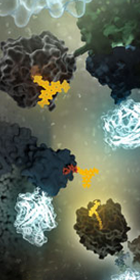In a paper published in the September 2014 issue of ACS Medicinal Chemistry Letters, researchers from GlaxoSmithKline in the UK and Germany report on the discovery, binding mode and structure:activity relationship of a potent BRPF1 (bromodomain and PHD finger containing protein family) inhibitor. This paper came to our attention as it is one of the first publications to apply Promega NanoBRET technology in an vivo assay that reversibly measures the interaction of protein partners. The technology enabled the identification of a novel inhibitor compound that disrupts the chromatin binding of this relatively unstudied class of bromodomain proteins.
What exactly are bromodomains and why do they matter?
Bromodomains are regions (~100 amino acids) within chromatin regulator proteins that recognize and “read” acetylated lysine residues on histones. These acetylated lysines act as docking stations for regulatory protein complexes via binding of the bromodomain region. Because of their role in chromatin binding and gene regulation, bromodomains have attracted interest as potential targets for anti-cancer treatments. Although some bromodomain-containing proteins (e.g., those in the bromodomain and extraterminal domain (BET) subfamily) are well characterized and have been identified as potential therapeutic targets, others are less well understood.
The subject of the ACS Medicinal Chemistry paper, the bromodomain and PHD finger-containing family (BRPF1) is thought to act as a kind of protein scaffold for the assembly of histone acetyl transferases (HATs), key proteins involved in epigenetic regulation of gene expression. The authors state that, because multiple bromodomains are often part of larger multiprotein complexes, it can be difficult to attribute functionality to bromodomain regions without specific probes or inhibitors to help identify their biological roles. Hence, they sought to identify compounds that specifically inhibit BRPF1 family proteins.
What is the significance of the paper?
In this paper, the authors report on the discovery, binding mode, and structure:activity relationship of the first potent, selective series of inhibitors of the BRPF1 (bromodomain and PHD finger-containing) bromodomain. They set out to generate selective inhibitors of the BRPF1 domain in order to better understand the functional role of this specific bromodomain region. Using an inhibitor discovery strategy based on other known compound-bromodomain interactions, a potent, selective inhibitor of the BRPF1 bromodomain was identified, synthesized, and characterized using in vitro methods.
To demonstrate the function of this compound in live cells, they used the NanoBRET assay for protein:protein interactions. With this assay, they demonstrated both the cell permeability of the newly identified compound and also the ability of the compound to disrupt chromatin binding of the BRPF1 domain. NanoLuc luciferase-tagged BRPF1 bromodomain and HaloTag-labeled Histone H3.3 were used for the NanoBRET assay. Dose-response curves performed with the NanoBRET assay enabled calculation of the cellular IC50 of the newly identified compound. A less active control analog compound was unable to inhibit the BRPF1 bromodomain:Histone H3.3 interaction, demonstrating assay specificity.
Finally, the newly identified compound was inactive in NanoBRET assays using a second BRPF1 isoform containing a natural insertion, a result that was consistent with the proposed compound mode of action. Confirmation that the new identified compound can enter cells and disrupt the BRPF1 bromodomain:chromatin interaction in a cellular environment suggests that it may be a useful compound for studying the physiological role and therapeutic potential of BCPs containing the BRPF1 bromodomain.
What exactly is NanoBRET?
NanoBRET is a BRET-based protein interaction assay that allows sensitive detection of interacting protein partners in live cells. Because it is reversible, it also can be applied (as in this case) to detect displacement of an interacting partner due to competitive binding of an inhibitor.
And here’s the paper:
Demont, E.H. et al. (2014) 1,3-Dimethyl Benzimidazolones Are Potent, Selective Inhibitors of the BRPF1 Bromodomain. ACS Medicinal Chemistry Letters. September 10 (Epub), DOI: 10.1021/ml5002932
Isobel Maciver
Latest posts by Isobel Maciver (see all)
- 3D Cell Culture Models: Challenges for Cell-Based Assays - August 12, 2021
- Measuring Changing Metabolism in Cancer Cells - May 4, 2021
- A Quick Method for A Tailing PCR Products - July 8, 2019

